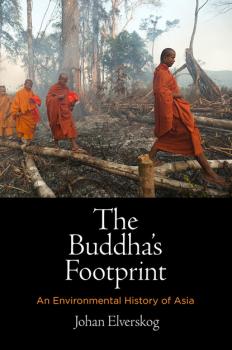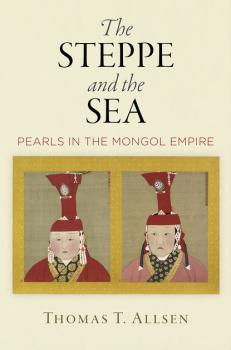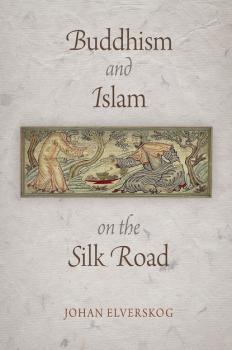Encounters with Asia
Скачать книги из серии Encounters with AsiaThe Buddha's Footprint
In the current popular imagination, Buddhism is often understood to be a religion intrinsically concerned with the environment. The Dharma, the name given to Buddhist teachings by Buddhists, states that all things are interconnected. Therefore, Buddhists are perceived as extending compassion beyond people and animals to include plants and the earth itself out of a concern for the total living environment. In The Buddha's Footprint , Johan Elverskog contends that only by jettisoning this contemporary image of Buddhism as a purely ascetic and apolitical tradition of contemplation can we see the true nature of the Dharma. According to Elverskog, Buddhism is, in fact, an expansive religious and political system premised on generating wealth through the exploitation of natural resources. Elverskog surveys the expansion of Buddhism across Asia in the period between 500 BCE and 1500 CE, when Buddhist institutions were built from Iran and Azerbaijan in the west, to Kazakhstan and Siberia in the north, Japan in the east, and Sri Lanka and Indonesia in the south. He examines the prosperity theology at the heart of the Dharma that declared riches to be a sign of good karma and the means by which spritiual status could be elevated through donations bequeathed to Buddhist institutions. He demonstrates how this scriptural tradition propelled Buddhists to seek wealth and power across Asia and to exploit both the people and the environment. Elverskog shows the ways in which Buddhist expansion not only entailed the displacement of local gods and myths with those of the Dharma—as was the case with Christianity and Islam—but also involved fundamentally transforming earlier social and political structures and networks of economic exchange. The Buddha's Footprint argues that the institutionalization of the Dharma was intimately connected to agricultural expansion, resource extraction, deforestation, urbanization, and the monumentalization of Buddhism itself.
Gu Hongming's Eccentric Chinese Odyssey
Known for his ultraconservatism and eccentricity, Gu Hongming (1857-1928) remains one of the most controversial figures in modern Chinese intellectual history. A former member of the colonial elite from Penang who was educated in Europe, Gu, in his late twenties, became a Qing loyalist and Confucian spokesman who also defended concubinage, footbinding, and the queue. Seen as a reactionary by his Chinese contemporaries, Gu nevertheless gained fame as an Eastern prophet following the carnage of World War I, often paired with Rabindranath Tagore and Leo Tolstoy by Western and Japanese intellectuals. Rather than resort to the typical conception of Gu as an inscrutable eccentric, Chunmei Du argues that Gu was a trickster-sage figure who fought modern Western civilization in a time dominated by industrial power, utilitarian values, and imperialist expansion. A shape-shifter, Gu was by turns a lampooning jester, defying modern political and economic systems and, at other times, an avenging cultural hero who denounced colonial ideologies with formidable intellect, symbolic performances, and calculated pranks. A cultural amphibian, Gu transformed from an «imitation Western man» to «a Chinaman again,» and reinterpreted, performed, and embodied «authentic Chineseness» in a time when China itself was adopting the new identity of a modern nation-state. Gu Hongming's Eccentric Chinese Odyssey is the first comprehensive study in English of Gu Hongming, both the private individual and the public cultural figure. It examines the controversial scholar's intellectual and psychological journeys across geographical, national, and cultural boundaries in new global contexts. In addition to complicating existing studies of Chinese conservatism and global discussions on civilization around the World War I era, the book sheds new light on the contested notion of authenticity within the Chinese diaspora and the psychological impact of colonialism.
The Steppe and the Sea
In 1221, in what we now call Turkmenistan, a captive held by Mongol soldiers confessed that she had swallowed her pearls in order to safeguard them. She was immediately executed and eviscerated. On finding several pearls, Chinggis Qan (Genghis Khan) ordered that they cut open every slain person on the battlefield. Pearls, valued for aesthetic, economic, religious, and political reasons, were the ultimate luxury good of the Middle Ages, and the Chingissid imperium, the largest contiguous land empire in history, was their unmatched collector, promoter, and conveyor. Thomas T. Allsen examines the importance of pearls, as luxury good and political investment, in the Mongolian empire—from its origin in 1206, through its unprecedented expansion, to its division and decline in 1370—in order to track the varied cultural and commercial interactions between the northern steppes and the southern seas. Focusing first on the acquisition, display, redistribution, and political significance of pearls, Allsen shows how the very act of forming such a vast nomadic empire required the massive accumulation, management, and movement of prestige goods, and how this process brought into being new regimes of consumption on a continental scale. He argues that overland and seaborne trade flourished simultaneously, forming a dynamic exchange system that moved commodities from east to west and north to south, including an enormous quantity of pearls. Tracking the circulation of pearls across time, he highlights the importance of different modes of exchange—booty-taking, tributary relations, market mechanisms, and reciprocal gift-giving. He also sheds light on the ways in which Mongols' marketing strategies made use of not only myth and folklore but also maritime communications networks created by Indian-Buddhist and Muslim merchants skilled in cross-cultural commerce. In Allsen's analysis, pearls illuminate Mongolian exceptionalism in steppe history, the interconnections between overland and seaborne trade, recurrent patterns in the employment of luxury goods in the political cultures of empires, and the consequences of such goods for local and regional economies.
The Teleology of the Modern Nation-State
Japan and China did not begin to emerge as unified political entities until the nineteenth century. Yet scholars and politicians persistently refer to «Japan» and «China» in discussions of earlier periods, as if the modern nation-state had long been established in these regions. Joshua Fogel here brings together essays by eight renowned East Asian scholars to demonstrate why this oversight distorts our historical analysis and understanding of both countries. The nation-states of Japan and China developed much later and, indeed, far less uniformly than usually conveyed in popular myth and political culture. Moreover, the false depiction of an earlier national identity not only alters the factual record; it serves the contemporary engines of nationalist mythology and propaganda. This interdisciplinary volume asks deceptively simple questions: When did «Japan» and «China» become Japan and China? When and why do inhabitants begin to define their identity and interests nationally rather than locally? Identifying the role of mitigating factors from disease and travel abroad to the subtleties of political language and aesthetic sensibility, the answers provided in these diverse and insightful essays are appropriately complex. By setting aside Western notions of the nation-state, the contributors approach each region on its own terms, while the thematic organization of the book provides a unique lens through which to view the challenges common to understanding both Japan and China. This highly readable collection will be important to scholars both inside and beyond the field of East Asian studies.
Translating Buddhist Medicine in Medieval China
The transmission of Buddhism from India to China was one of the most significant cross-cultural exchanges in the premodern world. This cultural encounter involved more than the spread of religious and philosophical knowledge. It influenced many spheres of Chinese life, including the often overlooked field of medicine. Analyzing a wide variety of Chinese Buddhist texts, C. Pierce Salguero examines the reception of Indian medical ideas in medieval China. These texts include translations from Indian languages as well as Chinese compositions completed in the first millennium C.E. Translating Buddhist Medicine in Medieval China illuminates and analyzes the ways Chinese Buddhist writers understood and adapted Indian medical knowledge and healing practices and explained them to local audiences. The book moves beyond considerations of accuracy in translation by exploring the resonances and social logics of intercultural communication in their historical context. Presenting the Chinese reception of Indian medicine as a process of negotiation and adaptation, this innovative and interdisciplinary work provides a dynamic exploration of the medical world of medieval Chinese society. At the center of Salguero's work is an appreciation of the creativity of individual writers as they made sense of disease, health, and the body in the context of regional and transnational traditions. By integrating religious studies, translation studies, and literature with the history of medicine, Translating Buddhist Medicine in Medieval China reconstructs the crucial role of translated Buddhist knowledge in the vibrant medical world of medieval China.
India in the Chinese Imagination
India and China dominate the Asian continent but are separated by formidable geographic barriers and language differences. For many centuries, most of the information that passed between the two lands came through Silk Route intermediaries in lieu of first-person encounters—leaving considerable room for invention. From their introduction to Indian culture in the first centuries C.E., Chinese thinkers, writers, artists, and architects imitated India within their own borders, giving Indian images and ideas new forms and adapting them to their own culture. Yet India's impact on China has not been greatly researched or well understood. India in the Chinese Imagination takes a new look at the ways the Chinese embedded India in diverse artifacts of Chinese religious, cultural, artistic, and material life in the premodern era. Leading Asian studies scholars explore the place of Indian myths and storytelling in Chinese literature, how Chinese authors integrated Indian history into their conception of the political and religious past, and the philosophical relationships between Indian Buddhism, Chinese Buddhism, and Daoism. This multifaceted volume, illustrated with over a dozen works of art, reveals the depth and subtlety of the encounter between India and China, shedding light on what it means to imagine another culture—and why it matters. Contributors: Stephen R. Bokenkamp, Bernard Faure, John Kieschnick, Victor H. Mair, John R. McRae, Christine Mollier, Meir Shahar, Robert H. Sharf, Nobuyoshi Yamabe, Ye Derong, Shi Zhiru.
Asian Medicine and Globalization
Medical systems function in specific cultural contexts. It is common to speak of the medicine of China, Japan, India, and other nation-states. Yet almost all formalized medical systems claim universal applicability and, thus, are ready to cross the cultural boundaries that contain them. There is a critical tension, in theory and practice, in the ways regional medical systems are conceptualized as «nationalistic» or inherently transnational. This volume is concerned with questions and problems created by the friction between nationalism and transnationalism at a time when globalization has greatly complicated the notion of cultural, political, and economic boundedness. Offering a range of perspectives, the contributors address questions such as: How do states concern themselves with the modernization of «traditional» medicine? How does the global hegemony of science enable the nationalist articulation of alternative medicine? How do global discourses of science and «new age» spirituality facilitate the transnationalization of «Asian» medicine? As more and more Asian medical practices cross boundaries into Western culture through the popularity of yoga and herbalism, and as Western medicine finds its way east, these systems of meaning become inextricably interrelated. These essays consider the larger implications of transmissions between cultures.
Buddhism and Islam on the Silk Road
In the contemporary world the meeting of Buddhism and Islam is most often imagined as one of violent confrontation. Indeed, the Taliban's destruction of the Bamiyan Buddhas in 2001 seemed not only to reenact the infamous Muslim destruction of Nalanda monastery in the thirteenth century but also to reaffirm the stereotypes of Buddhism as a peaceful, rational philosophy and Islam as an inherently violent and irrational religion. But if Buddhist-Muslim history was simply repeated instances of Muslim militants attacking representations of the Buddha, how had the Bamiyan Buddha statues survived thirteen hundred years of Muslim rule? Buddhism and Islam on the Silk Road demonstrates that the history of Buddhist-Muslim interaction is much richer and more complex than many assume. This groundbreaking book covers Inner Asia from the eighth century through the Mongol empire and to the end of the Qing dynasty in the late nineteenth century. By exploring the meetings between Buddhists and Muslims along the Silk Road from Iran to China over more than a millennium, Johan Elverskog reveals that this long encounter was actually one of profound cross-cultural exchange in which two religious traditions were not only enriched but transformed in many ways.
The Tongking Gulf Through History
Since 2005, a series of significant developments has been unfolding in the area of the Tongking Gulf under the rubric of an ambitious project called «Two Corridors and One Rim.» Proposed by Vietnam in 2004 and enthusiastically embraced by China, the project is designed to link their shared shores and hinterlands by superhighways and high-speed rail. An area that had seemed a backwater for two hundred years has suddenly become a dynamic engine of growth. Yet how innovative are these developments? Drawing on fresh historical insights and recent archaeological research in northern Vietnam and southern China, The Tongking Gulf Through History reveals that this region has long been a center of cultural, political, and economic exchange. From a historical point of view, contributors argue, the Gulf of Tongking has come full circle. Inspired by the Braudelian vision that regionality arises from long-term human interactions, essays avoid state-centered approaches of nationalist histories to focus on local communities throughout the Gulf. In doing so, they reveal a complex pattern of interrelationships and geopolitical factors that has shaped the gulf region for over two millennia. The first half of the volume covers the era from the Neolithic to the tenth century, when an independent state emerged from old Chinese Jiaozhi, or modern northern Vietnam; the second surveys the nine centuries that followed, in which only two states came to share the maritime shores of the Tongking Gulf. Together, the essays illuminate how millennia of recurring human interactions within this geographical space have created a regional ensemble with its own longstanding historical integrity and dynamics.
The Writing on the Wall
Students in Japan, China, and Korea are among the world's top performers on standardized math and science tests. The nations of East Asia are also leading manufacturers of consumer goods that incorporate scientific breakthroughs in telecommunications, optics, and transportation. Yet there is a startling phenomenon known throughout Asia as the «creativity problem.» While East Asians are able to use science, they have not demonstrated the ability to invent radically new systems and paradigms that lead to new technologies. In fact, the legal and illegal transfer of technology from the West to the East is one of the most contentious international business issues. Yet Asians who study and work in the West and depend upon Western languages for their research are among the most creative and talented scientists, no less so than their Western counterparts. William C. Hannas contends that this paradox emerges from the nature of East Asian writing systems, which are character-based rather than alphabetic. Character-based orthographies, according to the author, lack the abstract features of alphabetic writing that model the thought processes necessary for scientific creativity. When first learning to read, children who are immersed in a character-based culture are at a huge disadvantage because such writing systems do not cultivate the ability for abstract thought. Despite the overwhelming body of evidence that points to the cognitive side-effects, the cultural importance of character-based writing makes the adoption of an alphabet unlikely in the near future.









